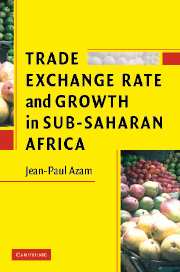Book contents
- Frontmatter
- Contents
- List of figures and tables
- Preface
- List of acronyms and abbreviations
- 1 Introduction and overview
- Part I Unrecorded trade in goods and currencies
- 2 The welfare implications of unrecorded cross-border trade
- 3 Parallel trade and currency convertibility
- Part II Foreign exchange constraints
- Part III Longer-term growth in African countries
- General conclusion
- References
- Index
3 - Parallel trade and currency convertibility
Published online by Cambridge University Press: 26 May 2010
- Frontmatter
- Contents
- List of figures and tables
- Preface
- List of acronyms and abbreviations
- 1 Introduction and overview
- Part I Unrecorded trade in goods and currencies
- 2 The welfare implications of unrecorded cross-border trade
- 3 Parallel trade and currency convertibility
- Part II Foreign exchange constraints
- Part III Longer-term growth in African countries
- General conclusion
- References
- Index
Summary
Introduction
Unrecorded cross-border trade is sometimes a response to a distortion affecting not the goods market but the foreign exchange market. If the parallel market for foreign currencies is illegal, then you cannot import goods legally unless you have a foreign exchange allocation from the official market. This was mentioned in chapter 2, and treated as a different form of QR bearing on trade flows. This cannot happen when the currency is convertible. On some occasions, as a transitory measure, some governments have introduced an “own-funds scheme,” whereby importers have been granted an import license without having to get their foreign exchange from the official market. This is a partial sort of convertibility, analyzed by O'Connell (1992a). However, whether the currency is convertible or not creates deeper differences between two economies affected by parallel trade. The aim of this chapter is to bring out some of these, emphasizing the different responses to some standard policy tools that may result.
The countries of the CFA Zone have long benefited from their membership of this grouping in terms of long-term growth performance (Devarajan and de Melo, 1987a; Guillaumont, Guillaumont, and Plane, 1988). This did not impair their ability to adjust to some short-run shocks, at least until the terms of trade (TOT) crash in the late 1980s (Devarajan and de Melo, 1987b; Devarajan and Rodrik, 1992).
- Type
- Chapter
- Information
- Trade, Exchange Rate, and Growth in Sub-Saharan Africa , pp. 45 - 66Publisher: Cambridge University PressPrint publication year: 2006
- 1
- Cited by



